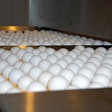
A new non-chemical intervention could improve the filtering and cleaning process of scalders, leading to better pathogen reduction at poultry processing plants.
“This technology has the potential to make a tremendous microbial impact with a simple, low-maintenance piece of equipment,” said Daniel Lehmkuhl, product manager, Technical Services, Safe Food Corporation.
“The industry is always looking for new non-chemical solutions that improve sustainability and reduce pathogens. This is our second innovation to address this need.”
Lehmkuhl is one of the many experts scheduled to speak at the Poultry Tech Summit, scheduled for October 30 - November 1 in Atlanta, Georgia. This one-of-a-kind in-person event facilitates the transition of innovation technologies from researchers and entrepreneurs into commercial applications for the benefit of the poultry industry.
Make plans to attend and take a look at the future of the industry.
Registration for the 2022 Poultry Tech Summit is now open with early bird savings available.
Using physics to remove sediment
Solids and sediments that accumulate in the scalder during the processing day can result in cross-contamination and increase the pathogen prevalence on product. Additionally, employees must shovel the solids and sediments out of the scalder with a shovel at the end of production, adding another task to the sanitation process.
The non-chemical intervention uses physics and natural forces to remove sediment from the scalder into the discharge tray and down the drain without any moving parts. It can complete up to five complete recirculation loops an hour on a 2,000-gallon tank.
“The physics behind this technology aren’t new, but we have been able to harness them and apply them to this specific application,” explained Lehmkuhl.
In initial tests, the approach resulted in the reduction of several pathogens, including Campylobacter. In addition, the technology could reduce the amount of time needed to sanitize the scalder in poultry processing plants.
Safe Foods Corporation plans to begin tests of the non-chemical intervention for poultry scalder filtration in commercial facilities this summer.
“We’re excited for this next step in sustainable pathogen reduction,” he said. “There are opportunities there to hopefully revolutionize what comes in that space.”
Attend the 2022 Poultry Tech Summit
Join an exclusive international gathering of industry-changing innovators, researchers, entrepreneurs, technology experts, investors and leading poultry producers at the 2022 edition of Poultry Tech Summit on October 30 - November 1 in Atlanta, Georgia.
Attendees can expect the same groundbreaking innovation and insightful presentations that made the previous events well-attended with deep dialogue on new prospective solutions and next-generation technologies. Poultry Tech Summit focuses on the transition of innovative technologies into commercial applications to advance the poultry industry.
Registration is now open with early savings available.


















